Tina from My Gardener Says hosts a monthly meme – Wildlife Wednesday – I am really happy to be joining in for the first time and sharing some of our very welcome visitors.
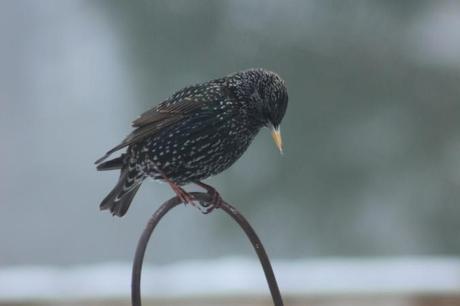
Starling in decline and a Red Status bird but a regular January visitor to our garden
We have a wildlife friendly garden where we aim to provide some shelter and a place to forage for almost all creatures. Some like slugs are collected in a bucket and taken to the field behind, where we hope the frogs, toads and voles living in the drainage ditch make the most of them. The long mild autumn and bountiful hedgerows have meant birds have had plenty to eat elsewhere but the late January drop in temperatures have brought more birds back to our feeders.
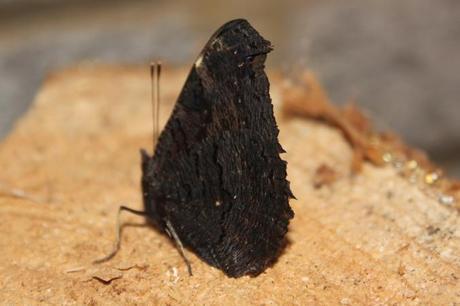
Hibernating camouflage of Peacock Butterfly
An unwitting stowaway came up from the log store into the covered area next to the house on the 4th of January, we had accidentally disturbed a hibernating Peacock Butterfly, I dithered wondering if I should return him or her to the log store and then looking a little ragged it started to open its wings, grabbing my camera I took a couple of photos and then decided it should stay in the new log pile and hopefully continue hibernating near the house.
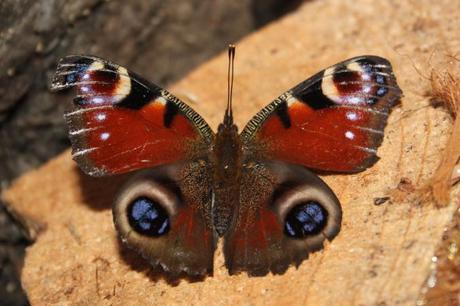
Peacock Butterfly Jan 4th 2015
We were surprised to see a large Buff tailed Bumblebee on the Hellebores in mid January, and believe it could have been a Queen briefly coming out of hibernation to gather food. I read they build their nests underground and had worried a week later that the late January colder temperatures would be detrimental but learn they can survive underground up to minus 19c. I wasn’t quick enough to photograph her but this is a link to the very helpful and excellent Bumblebee Conservation Trust website, which explains amongst other things how Bumblebees hibernate in winter. I thoroughly recommended a visit to their website.
January also brought another visitor, I had admired the squirrel deterrent Jessica from Rusty Duck has and foolishly or not wished for a squirrel to visit my garden. Well we have one now, thats a squirrel not the deterrent. The gray squirrels are an exceptionally prolific introduced species from North America that have outrun our native Red Squirrels.
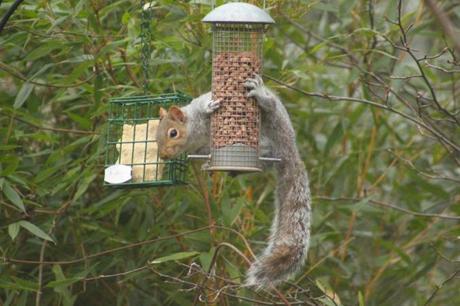
Squirrel on the peanut feeder
We only have one Squirrel visiting our garden and its not a problem, however the Forestry commission and Defra are between them very sadly planning to introduce a cull which they say is designed to protect Woodlands and native Red Squirrels. This follows on from the failed waste of money debacle of the Badger cull, instigated by the current government. The UK has around five million Greys and an estimated 120,000 and 140,000 Reds, with 75 per cent of them in Scotland. Understandably Animal charities are strongly objecting to the plans. Hugh Warwick wrote an excellent article in the Guardian at the tail end of last year “Should we cull gray squirrels to save the native red?” he concludes “The biggest threat to the natural world is our lack of understanding – without understanding, without a connection, we simply cannot care deeply enough to make the changes needed to ensure wildlife and humanity can live together.”
January continued in a rollercoaster of temperatures and a just before the RSPB Big Garden Birdwatch, temperatures dipped again bringing yet more bird species into our garden. Folk are asked to count bird visitors for just one hour over the weekend of 24th-25th January. To date 199,885 individual bird counts and nearly 6 million birds have been recorded with the RSPB. We recorded 12 species in a really happy relaxing hour of drinking coffee and looking out of the window guilt free. Not all of the regulars showed up in that hour but amongst many others one of the local pheasants appeared.
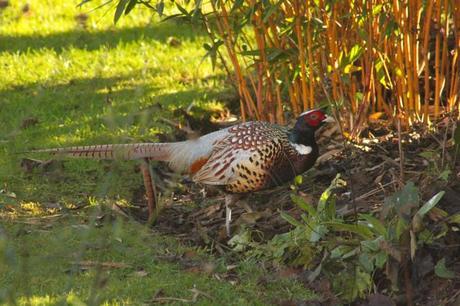
Male Pheasant
We live in a rural area, pheasants are bred nearby for people to shoot. Lately one male with a damaged tail and two females have been regular visitors and they eat up the seed dropped from the feeders. Yesterday I sadly noticed a pile of female pheasant feathers in the landlocked wild field at the bottom of our garden. Most likely a fox.
Thankyou so much if you read to the bottom of my post and if you can help me with this little Blue Tit I would be grateful, apologies for the blurry photo, on January 31st I spotted what looked like a youngster with a partial moult of feathers is that usual or is something else afoot here?
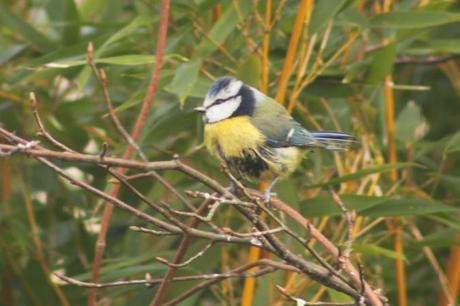
Blue Tit and partial moult
Many thanks to Tina for hosting, please visit her lovely blog My Gardener says to see Tina’s and other Wildlife Wednesday posts. Or join in this month or maybe next month on the first Wednesday.
Happy Wildlife spotting!
